Packaging Materials & Containers
Markings and labels used on packages
From the point of view of the railways there seem to have been two ways of marking a consignment, either a tied on paper card label (typically about three inches by six inches with the corners cut away at the end with the reinforced hole for the string) or a pasted on paper label. Pre World War Two the pasted on labels seem to have been commonly about eight inches square, by the later 1950's or possibly the early 60's this had changed to a rectangle about eight inches by four inches. The former seem to have been most common on passenger platforms but in goods yards, although a tied-on label is sometimes visible, the pasted on type seems almost universal. Both types were light in colour, white, cream or possibly light brown.
Most of the packages described below would have been branded in some way, items such as wooden cases used for bottles of whisky, although intended to be disposable, would have the name of the distillery and the brand printed on them (often apparently using a stencil and often not done terribly well), but re-usable wooden containers such as barrels usually had at least part of their markings carved into the wood. The reusable containers had to be returned to the factory for refilling and on these the name of the town in which the factory was based was usually the most prominent word.
Goods arriving at the docks were usually more elaborately marked than purely inland traffic. As well as markings regarding the destination (usually written larger than the other markings) applied by the sender 'port markings' were applied by the ships staff to all consignments for a particular port. These were intended to avoid cargo being 'over carried' (ie not unloaded when it should be). An example might be a red triangle or double barred cross each about six inches to a foot high painted on the side of every case in a consignment. Steel bars or rods often had bands of coloured paint roughly applied at one end.
In 1952 a standard set of markings was adopted by international shippers to indicate dangerous cargo. These markings were typically six inches to a foot high and were found on any package used for dangerous materials, notably barrels and drums but also cases and occasionally crates. Dangerous cargo was divided into seven categories, each with a specific marking.
| Explosives | Three red triangles |
| Inflammable (by itself or
in contact with air/water or shock/friction) | Two red triangles |
| Inflammable | One red triangle |
| Corrosive or caustic | One green triangle |
| Oxidising | One yellow triangle |
| Toxic | One black triangle |
Radio Active
| One blue triangle
(replaced by the radiation symbol) |
Basic Container Types
Broadly speaking there are four ways of shipping materials; solid objects can be placed in wooden or wicker boxes or sacks and some items such as nails were shipped in small wooden barrels (see below), liquids travel in sealed containers, tins, barrels and drums, light but bulky material such as wool, jute and cotton is formed into bales and materials which do not need protection from rough handling can be shipped in bulk. More recently (since the 1970s) three new shipping methods have come to dominate the scene; containers, pallets and Intermediate Bulk Containers. These are discussed separately in Unit Loads - Containers Pallets and IBC's.
The 'brown paper parcel' tied up with string was certainly in use by the later 1920's. Parcels could be quite large, I have seen photographs with parcels up to four feet by three feet by about two feet in a goods depot. I am not sure what was in the parcels but candidates would include knitted woolen clothing.
Goods requiring protection in transit (anything from butter to cuckoo clocks) need a solid box round them, some materials such as tea were shipped in boxes as a matter of simple convenience. Boxes however come in a wide range of types; Cases are wooden boxes with solid sides, chests are light weight boxes often with the reinforcing framework on the inside, crates are open wooden framework boxes and cartons are cardboard boxes. Plywood only became available in the 1930's but it was soon used for a range of packing duties, notably the small 'tea chest' that used to be common in house moves (see below for more on these chests). Tinplate (thin sheet iron or later steel coated with tin to stop it rusting) has been used as a packaging material since the 1870's and galvanised iron was introduced in the 1850's (an early application was milk churns). Baskets and hampers are made from wickerwork and were commonplace up to the 1960's. Sacks were used for a wide range of duties, the materials used determined by the duty to which they would be put.
Baskets and Hampers
Baskets date back thousands of years, they are cheap, light weight, easily repaired, durable and fairly strong. British baskets and hampers were made from Willow which was grown for the purpose in 'osier beds' in swampy land or river valleys. The baskets had a shiny dark brown finish with streaks of lighter biscuit colour in it. Baskets or wicker containers were used for the jobs we would now associate with corrugated cardboard cartons and plastic crates. Some idea of the importance of this material in British industry and commerce can be gained from the fact that during the Second World War basket making was a 'reserved occupation', the workers being exempted from conscription as their contribution to the war effort was more important. On pre-world war two passenger platforms up to half the 'boxes' cluttering the scene would be wicker, in goods sheds the proportion varied depending on the principal trades of the town but every shed would have a few hampers in view.
Traditional British basket making went into decline after the war, the baskets and hampers were still a common cargo on the railways in the 1960's but had virtually disappeared by the beginning of the 1970's as firms switched to cardboard cartons transported on pallets. Most modern basketwork is imported and has been made on a frame by semi skilled workers, the materials used tend to be a much lighter colour. Also the materials used are not so sturdy but the modern uses tend to be domestic and decorative rather than industrial.
Wicker (basket work) boxes were used for a wide range of goods including fruit and vegetables, the example in the sketch below is based on baskets photographed at a vegetable market at about the time of the First World War, the baskets were marked with a twelve inch (30cm) high initial letter(s) on the end (these could be black, red or blue in colour) to identify the owner.
Round baskets were used for shipping fruit, these tapered so they could be nested for shipping back when empty. They had woven handles near the top and were formed into a tall stack (perhaps seven feet long) with lines passed down through the handles. These were then stood on end in open wagons and roped in to secure them. From a modelling point of view the easy option has to be the loaded wagon covered with the sheet. This can be represented using lengths of Biro re-fill tube pushed into a bed of Milliput in the wagon and sheeted over with a paper tarpaulin. For an unsheeted load the only option is to use a tube of suitable diameter (about 2mm to 3mm maximum) with a paper wrapper extending 3mm above the top. Adding rings of cotton thread represents the woven top of the baskets then loop a strand of fine fishing line across the top and down the sides (the ends can be tucked into the tube and secured with Milliput). The final touch would be short (1.5mm) lengths of thread secured across the fuse wire to represent the woven handles. You do need a lot of these to fill a wagon, personally I'd go for the sheeted option. Farmers used open topped 'potato hampers', roughly thirty inches cube when harvesting but they were (I believe) also used for shipping potatoes to market.
The Lancashire cloth mills used big open topped square baskets called 'cloth skeps' which had rollers fitted in the base, adding a lid of the same material, held down with short leather straps, produced a useful container for shipping their finished goods. Similar large hampers were used by the hosiery makers in Leicestershire and by the boot and shoe makers of Northamptonshire. These big hampers are still used today by theatrical companies to carry their costumes.
Smaller hampers were used to carry yeast from the distilleries for sale to bakers and crockery from the potteries to the shops. Commercial travelers used these lightweight wicker hampers to carry their wares. Dairy produce such as butter and eggs were often shipped in basketwork containers and fishermen used wickerwork traps for salmon, eels, lobsters and crabs and open baskets for landing their catch. The standard 'delivery bike' used by butchers, bakers and the like, had a small front wheel under a metal frame to hold a standardised open topped wicker basket to carry the goods. These bikes were still occasionally seen in the 1960's but had disappeared by the 1970's.
Wickerwork baskets are difficult to model in N, for OO gauge I used fine nylon stocking material to cover a length of strip wood which had been cut to size, stuck on with diluted PVA glue. In N a better option would probably be to use a printed paper wrapper on a strip of Plastruct tubing or strip wood. Producing the original larger than required and then using a colour photocopier to produce the final sheet would allow you to add the lettering to the sides. To make a basket with surface texture (although this will be over scale in N) I would probably form the basket from a block of putty, smoothed with a wet knife and embossed by pressing a fine woven cloth against it. The top was noticeably separate, in OO I used a scrap of stiff paper with the material glued to it with PVA and then cut to size, in N I suggest embossing a scrap of 10 thou card by coating it with solvent and pressing the material into the softened surface (removing it before the solvent evaporates) and gluing the resulting 'lid' to the top of the hamper when the solvent has evaporated.
Fig ___ Hampers
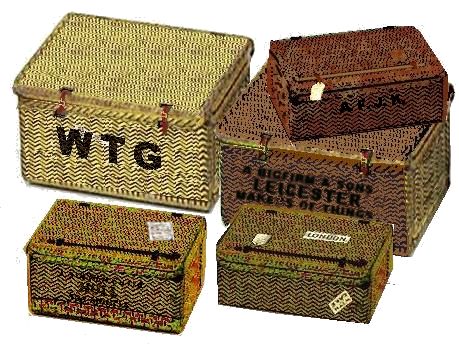
Wicker baskets were marked with paint, the lettering had to be at least a couple of inches high because of the nature of the material but the markings were clearly visible. These were definitely reusable containers and the name of the town was usually in lettering twice the size of the rest of the markings.
Cases and Crates
Most items were shipped in light wooden crates and cases, often packed with straw. Cases and chests are technically closed wooden boxes and crates are open wooden frames forming a box shape. One point to note is that size does not always relate to weight, the sketch below is based on a photo of lady porters during the First World War, the cases are large but apparently not terribly heavy. The point being that we can use legitimately use limited numbers of cases from other scales to clutter a goods yard or platform scene.
Fig ___ Large crate on a sack truck
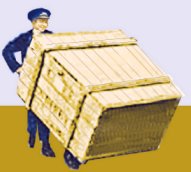
The Roco Minitanks range of models includes 'ammunition boxes', these come with separate lids and you get 28 long boxes 13mm x 2mm x 3mm and 28 rectangular boxes 8mm x 3mm x 5mm. You can combine two Minitanks boxes or two lids (the lids need the edges filling after sticking together) to produce another four types of box.
Fig ___ Roco ammunition boxes
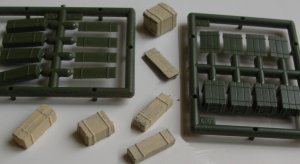
The cases used for China or similar small fragile items can be made up by stacking three oblong layers of 40 thou (about 1mm) plastic card and adding strips of paper to form the bracing. These cases were just long enough to fit crosswise inside an open waggon, although it was usual to have some loaded lengthways with some laid across at one end. To represent larger planked cases one option is to clad a length of Plastruct tube in 'planked card' but you need to bore a hole into the bottom to allow the fumes of the glue to escape when you attach the ends. I used to use paper wrappers laid over strip wood. Colour the paper first and add 'plank lines' using a sharp pencil. PVA sticks paper to wood, a wash of polystyrene glue (Mek Pak) will stick paper to plastic. The external framing (where fitted) can then be represented using coloured strips of post card.
Plywood chests, for example tea chests, can be made from strip wood or Plastruct tube. A chest was actually a British measurement of tea ranging from 80 to 84 lbs. By the 1950's (possibly much earlier)the standard was the half chest, which is what most people think of as a 'tea chest'. I was not able to find a definite specification for tea chests but Guy King was kind enough to measure some for me. He found two standard sizes; 18 ½ x 18 ½ x 20 inches (46.4 cm x 46.4cm x 50.8cm) and 20 x 16 x 23½ inches (50.8cm x 40.6cm x 59.7cm). This is about the same size as cases in a photo I have of cases of tea being unloaded from a ship in 1919, you can get away in N with 4mm cubes, painted cream with light gray along the corners and black dots to represent the stenciled markings on the sides. To model the plywood tea chests in N I used 5mm lengths of STFS-4, fill the ends with putty and sand smooth, I cut them 5mm long to allow for losses when sanding.
Matches were also shipped in plywood chests about two foot cube for which Plastruct STFS-6 is the best option.
The tea and match chests were natural wood colour (light earth is about right, perhaps mixed with cream) and were clearly marked usually with a red or black painted stencil showing the manufacturers name and often the logo. Paint light grey stripes along the corners to represent the metal reinforcing (the matt bare metal paint (some brands call it aluminium) now available would be better for this, 'silver' is too shiny for a model in this scale). Not all match chests had metal reinforcing along the corners.
Cut flowers were shipped by rail in plain wooden cases, these seem to have been about three feet long, six inches deep and either nine or eighteen inches wide. In Janet Russel's book on GWR Company Servants (see Bibliography) there is a photograph showing these, each box was clearly marked 'Deposit 2/- in black on one (or possibly more) of the long sides. The boxes were tied together with string, up to four at a time.
Crates can be made up using Slaters plastic strip, I use a lot of 10 x 20 thou strip for this work in N (corresponding to 2x3 par). For larger crates I have had success cutting slices from the end of a Plastruct square section tube to form the frames. To make life easier use a solid rectangle of card for the 'floor' (glued to the inside of the Plastruct frames) as this holds the ends square while you add the rest of the framing. When adding the strips to the sides do one side at a time, then lay the crate on a cutting board and trim the ends, if you do all the sides at one go you will find it difficult to do the trimming. Quite large items were crated for shipping, so you can build a crate round some odd shaped lump of plastic from you bits box or just glue some scraps of sprue together. The photo shows two such crates being made, all that is required is a load glued inside and ends adding again from 10x20 thou strip.
Fig ___ Making crates for a wagon load or yard scene
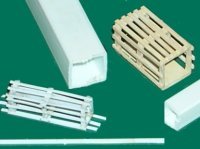
The crate was often packed with straw, for which I would suggest the lint recovered from a tumble dryer bleached (if necessary) to a light colour. In photographs of town goods yards you often see crates like this that have been emptied, usually with straw in the bottom and hanging from the open end. I have no idea why they were emptied at the yard.
Vegetables such as cabbages were shipped in light wooden crates, these can be made up using two lengths of etched brass signal ladder bent into mating U shapes and soldered or super-glued together. The cabbages can be represented using cigarette paper coloured green (sap green water paint on cigarette paper is good for this). Cut the paper into rough squares and crumple these up (a drop of diluted PVA in the centre before crumpling holds them to shape). Paint the crate (Humbrol 'dark earth is about right) then poke the crumpled paper into the crates between the 'rungs'. You can use bits of pan scourer however the green is much too blue for vegies and as against you have painted the stuff it is quicker to use paper.
Live chickens were routinely shipped (in parcels trains) in light wooden hutches with 'chicken wire' mesh on one side, with a hole for putting in feed and water.
Fig ___ Chickens in crates

Canvas and Sackcloth Bags
Note: The sketches I have made are all based on photographs but the best I can say is that they represent 'typical' sacks for the stated period.
Canvas or 'sailcloth' is a weave not a material, actually a 'twill' in which the threads running north-south are more numerous than those running east-west. Canvas is made from hemp or more recently cotton and cotton canvass, especially if made using Egyptian cotton, is fairly waterproof as when wet the fibres swell and seal the holes in the weave. Notwithstanding that characteristic however canvas was waterproofed by coating it with a mixture of coal tar or linseed oil and 'lamp black' (very fine soot). The canvass used on the railways was made of mixed materials, the warp being perhaps hessian with the weft being perhaps cotton or linen (for strength). Canvass was mainly used on the railways as large sheets to cover wagons but similar sheets were sometimes wrapped round and roped to individual cases or crates. Very occasionally the sheet would be cut and sewn round the item, this was usually done using un-tarred canvas, if the item was being shipped abroad the canvas might then be painted to make it weather proof.
Sackcloth is also a weave not a material, again it is essentially a 'twill' which has more 'warp' (north-south strands) than 'weft (east-west strands), sackcloth is (generally) lighter and more open weave than canvas. Sackcloth can be woven in the form of a tube and cut to length to make bags but it was usually cheaper to fold a length in half and sew along each side and hem around the mouth. Sackcloth was originally made of flax, but now almost exclusively made of jute or of hemp. Flax is expensive and was I believe only used for decorative materials and up-market canvass by the 1930's. Top quality sacking is usually made from hemp but jute is cheaper and was widely used for the likes of coal sacks for local house supplies. Jute is strong and because of its rough surface, ideal for stacking and palleting, it's tear resistant and not susceptible to hook damage, the woven cloth allows goods to breathe, it's easier for marking and overprinting. Jute is second only to cotton in the scale of its production, although it has to be harvested by hand (at least up to the 1950s). It varies in colour from light brown to almost grey. Sacks were valuable items so they were often printed with the name of the firm using them. Where the contents were not liable to taint the sack might be washed with creosote to prolong its life, coal sacks were often so treated. An untreated coal merchants sack would typically last about a year, creosoting it might extend the life to two years.
Light sackcloth was often wrapped round bulky bales of material such as cotton cloth and the like to protect it from marking in transit For valuable goods an inner lining of tarred paper, with the tarred side facing outwards, could be added to protect the goods from staining. Dundee was the major manufacturing centre for jute sacking. By the 1930s wool, imported from Australia and New Zealand was packed (compressed) in pre-made cloth bags, fairly light in colour, which were sewn shut. These end up about three feet cube after a second pressing (in a dump press) into a smaller jute (more recently nylon) bag. The bale could be further compressed (or 'double dumped) but I understand that this was not terribly common. The press added (typically) three metal bands round them to hold them together. Modern Australian bales they weigh in at between 110 kg and 204 kg depending on the nature of the wool but in the 1930s the heaviest were those from South America at about 1000lbs and the lightest were from New Zealand at about 280lbs.
In agriculture sackcloth bags were used for storing and transporting bulk foods such as onions, potatoes, peanuts, Soya, sugar, salt, flour, rice and other grains and by farmers for holding seeds and chaff, animal foods and fertiliser etc. British containers are defined by volume (much easier to work with than weight), the key unit being the gallon (277 cubic inches or 4550 cubic centimetres). A bushel was a standard size for a cloth bag and this held eight gallons or about one and a quarter cubic feet (0.0364 cu metres), this is about the capacity of a garden wheelbarrow.
Bags was a general term covering everything from small 1 lb (0.5Kg) bags used for green beans to very large three or four bushel hessian sacks used for grain. Depending on the type of grain the larger sacks could weigh in at up to two and a half hundredweight when filled (the accepted weight when empty was 4lb or about 2Kg). Man handling these large heavy sacks is one reason so many farmers and farm hands needed walking sticks in later life.
One bushel sacks were not very common, however when I did some research I found the details of sizes used somewhat confusing. Bags were certainly made in one, two, three, four, six and eight bushel sizes. The 'wool sack' on which the Speaker of the House of Commons sits is a three bushel sack (the tradition originated because wool was at the time the single most important commodity in the realm). I understand that cattle feed was sold in two bushel bags and I remember being told by an old farmer about the 'standard three bushel sack' being used for grain. The three bushel 'sack' or 'bag' held 24 gallons or about four cubic feet (110 litres). Filled with wheat, corn or peas that would weigh in at something over 190 lbs or about 80 Kgs and barley, rye or cottonseed would weigh 25 percent more, these were heavy sacks. Technically the legal definition of a 'sack' is indeed a three bushel bag, however I have come across numerous references to grain being shipped in the four bushel bag (four bushels being known as a 'coomb' when talking of corn).
Fig ___ Typical pre war grain sacks
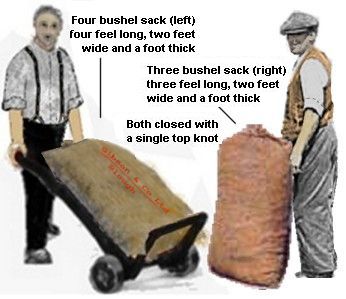
The largest dry volume measure in common use was probably the Chauldron (36 bushels, 864 gallons, 139 cu feet or just under 4 cu metres), this was the volume of the well known chauldron hopper wagons used for coal by the railways, coal mines and coal handling docks from the 1800's right up to the early 1970's and equates to roughly three tons of coal. The chauldron was the legal limit for horse drawn coal waggons heading for London as it was felt that heavier loads would cause too much damage to the roads. Oddly enough there were sacks made of about this size, one application being importing feathers from the Far East for use in mattress stuffing. I have seen photographs taken in the 1920's showing a flat bed four wheeled horse drawn delivery cart carrying just one of these sacks.
Once the canals began operating a farmer might send his produce a considerable distance with no guarantee the empty bags would be returned. Sacks were valuable goods and a new industry of sack hiring firms stepped in, operating from offices throughout the area they covered including any railway stations where there might be a regular trade. Firms operating in this areas included Chisolm, Fox, and Garner for East Anglia whilst West of England Sack Hiring Co. Ltd. and Gopsill Brown & Sons Ltd. both had contracts with the GWR to supply sacks to their customers. These two latter companies merged to form the West of England Sack Contractors Ltd. in the late 1930s and remained in business with offices at many railway stations into the 1960s and possibly beyond. As the sack passed from farmer to merchant to customer each one filled out a paper chit accepting responsibility for the sack and liability for the rental fees. If a sack were seriously damaged or lost 10/- (50p) was a typical replacement fee for the post war period.
The railways themselves participated in this trade, certainly the Midland Railway and LNER both provided such a service, and the common availability of sacks for hire at the local railway station meant that hired sacks were often referred to as 'railway sacks'. I understand that BR stopped renting sacks soon after nationalisation but the private firms continued in operation at least into the 1980s.
There seems to have been two principal ways of securing the open end of a bag, either it was brought together, folded over and tied off in a single central knot or it was sewn closed with the ends being tied off with the ends of the sewing twine to form distinct 'ears'. The photo below was taken in the 1930s and shows a ship being unloaded, not the size of the sacks and also the single large knot in the top.
Fig ___ Working a ships hatch in the 1930s
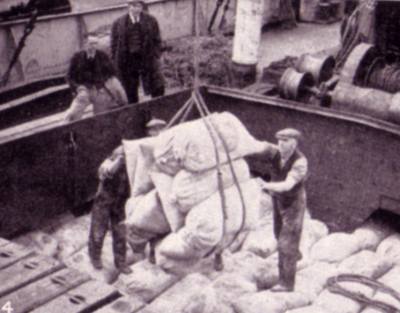
Some sacks seem to have been sewn rather neatly closed, showing neither the central knot or the ears at the top corners but this was the exception rather than the rule for cloth sacks. Potato or onion sacks had bigger ears, closer together, they were secured by pulling half a two foot length of twine through the top of the bag and tying it off. The two trailing ends were then used to tie off the ears. Sacks containing material such as grain or sand could not be secured in this way or they would leak, they have more stitching and smaller ears.
In the examples shown the coal sack is taken from a photograph from the 1980s and I believe some coal had been removed before the photograph was taken as I remember them being more full than this. The building sand was packed tight and forming a smooth oval sausage shape, the top was folded and tied into a single bundle. The animal feed sack (a 'two bushel' sack) was again a smooth looking material, the bag was sewn along the top but had small 'ears', this was a much flatter shape than the bag of sand. The potato sack was coarse brown hessian sacking secured as shown and distinctly 'lumpy' in outline. The big sack on the end was being loaded into a ship, faint markings were visible but not clear enough to copy. This had a visible seam down each side and was folded and sewn closed as shown. Coal and coke sacks were not (as far as I am aware) fastened closed but were used with the top open as shown below. In the 1960's coal merchants switched to 'nylon' (actually I believe this was polypropylene) sacks, these were a light grey colour, this is the basis for the illustration below.
Fig___ Sack types and methods of closing
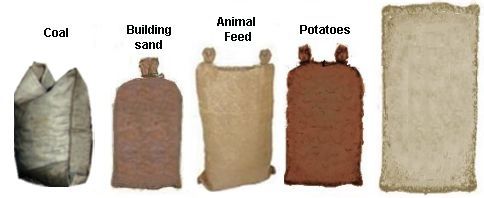
In the 1970's farmers also switched to woven polypropylene sacks (of much lighter construction than the tightly woven heavy duty coal sacks), mainly for root vegetables such as potatoes and onions, These agricultural sacks were a an orangey red-brown colour with black markings and (from memory) they were sewn closed with no 'ears'. By this time they usually have been shipped strapped down to pallets.
Sacks were valuable items and were often marked with the name of the owner and sometimes with the nature of their business. I believe the sack hire firms all marked their bags with their company name. Finding pictures showing the markings on sacks has not been easy, however I would suggest that the West of England Sack Company mentioned above had their name of the bags as I have seen them referred to as West of England sacks.
Fig___ Sack markings taken from photographs
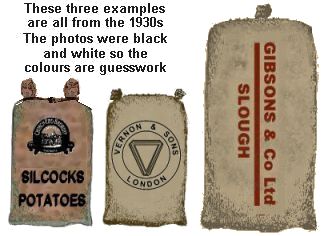
By the 1940's I understand there were standard markings on sacks, mainly I believe to indicate their intended use and so prevent contamination, but I have not been able to trace any details of these markings.
Most sacks passing through the railway system did not carry individual labels, the details of the number of sacks and their intended destination being recorded on the associated consignment note.
Sacks would normally be sheeted over in the railway wagons, in part to allow them to be tied in securely, but I have seen several pictures of them piled onto a road cart with no covering. There are sweets called 'ticks' which serve well for the larger 'three bushel' sacks in British 'N', a small blob of Milliput on the 'top' serves to represent the central knot, alternatively a short length of thread glued to one end represents the sewn closure. Up to the 1980's you could buy liquorish sweets called 'Nigroids' which served well for coal sacks in N, these were sold in small tins and may still be available although I have not seen any for some years now.
Since the 13th Century there had be numerous attempts to establish a system of weights for the sale of goods, wool being the most important commodity most of the laws related to its sale. After a hundred years or more of slight adjustments the 364-pound 'sack' was legalized by Edward III in 1340 when he declared the sack weighed 26 stones, each stone weighing 14 pounds. These values for the stone and sack survived for six centuries but in practice farmers were accustomed to selling grain by volume and continued to do so (weighing the filled sacks would simply have represented another job with no driving practical advantage). The general change to using weight as a measure on the farms, for example selling potatoes by the hundredweight, seems to have occurred in the later 1920s or early 1930s, as 'barn scales' became more popular with the farmers. These consist of two platforms, each about two feet square supported to either side of a central metal frame (usually with a plank of wood on top of the frame), the farmer placed two 56lb weights on one side and the sack on the other, filling the sack until it 'tipped'. There was no 'needle and dial', the weighing was entirely managed by the weights on the second platform. Grain was then sold by weight but the large sacks remained in use so farmers had a table showing the actual weight a four bushel sack should hold of each commodity. By the later 1930s the number of smaller sacks in use seems to have become more common. Grain continued to be shipped in the large pre-war sacks after the war but bulk storage and handling of grain really took off in the later 1950s and by the end of the 1960's the once common sack had largely disappeared. They were not missed by the farm hands but they had found a range of other uses and gardeners for one missed them (when sewing a new lawn laying sacks over the top and watering these for a couple of days resulted in a neat lawn of even length).
Paper Sacks
After the late 1930s the term 'bags' was also used in shipping circles for paper sacks. The multi-wall paper sack was introduced in 1920s by the English Paper Sack Company, now part of Medway Sacks. At first there were doubts about the viability of a paper sack so a demonstration was arranged where several filled bags were dropped from a considerable height. Non burst and the paper sack soon dominated the market for shipping materials such as cement, lime, animal feeds and flour.
There have been several developments which produced visible differences in these sacks. Pre-war examples were tied closed at the top, although they were squared off with well developed `shoulders' to the bag. This can be represented by simply adding a small blob of Milliput or similar modelling clay to the centre of one end on commercial whitemetal sacks. From the mid 1940s when mechanical filling was introduced until the late 1960s sacks were sewn closed (these had a ridge along the top edge, usually with a strip of blue reinforcing sewn onto it). I believe it was in the 1960's that bagging machines folded and pasted the bags after filling, resulting in a more square end. The commercially available models of paper sacks that I have seen are all of the glued type.
The now common 56 lb (25 Kg) paper sack was introduced during the Second World War for dense materials such as cement, replacing a 1 cwt (hundredweight or 51 Kg) type which was considered too heavy for the women working in the factories.
I believe that two colour printing on all sacks and bags was not introduced until the 1950s, so cloth bags would be light brown and paper sacks would be light brown (white in some cases), both with a single colour `logo' applied. The sketches below are based on my own and other peoples memories and may be inaccurate, however they are close enough to pass muster. The CMC inside the circle was replaced by Blue Circle in the mid 1960s, the plain blue ring came in (I think) in the later 1980's or early 1990s (I understand the company name actually changed from CMC to Blue Circle in about 1995).
Fig ___ Paper Sacks
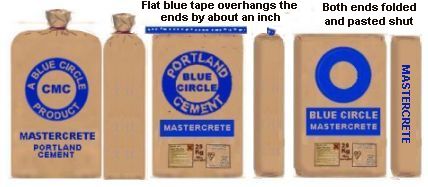
Bales
Probably the most familiar bale is the bale of hay (often called a 'truss'), a rectangular block of hay tied with twine to simplify the supply of food for horses. These were originally cut from a pile of hay called a rick using a knife and although mechanical baling machines were in use in the early part of the twentieth century the rather 'shaggy' hand cut bale remained common in Britain until after the second world war. Hay in the 1920s and 30s was typically five or six feet long and formed a well integrated mass in the hay rick. Hay bales were regularly shipped by rail from the country into the towns, they were loaded into open wagons to a depth of about three feet above the wagon sides and sheeted over. Loose hay could be piled in a wagon up to the full height allowed by the loading gauge and then covered with two wagon sheets but I believe this was a less common cargo than bales. The bales or trusses of hay were supposed to weigh in at about 60 pounds (28 Kg) but this was always an approximate measure.
The size of bales is something I found very hard to pin down, one of the constraints is or was the need to man-handle the goods, hence weight was more important than size. The size of a bale was therefore determined by how compressed it was, from the 1890s steam power presses wee in use to compress both wool and cotton into smaller bales, banded with metal strip for shipment.
As an example when looking for details of cotton bales I found that, within the USA, they shifted uncompressed bales about five feet long by four feet wide and about two feet high (below left). Steam power and hydraulic compressors allowed the compressing to be done at the gin from the 1890s. The standard was for a density of about 32lbs per cu ft (in the 1970s this was reduced to 28lbs per cubic foot). By the early 20th century imported American bales were well all compressed and banded, however the bales I have seen in pre-Grouping (pre-1924)photographs were typically about seven feet long and about three feet square (14 on a ten ton wagon as shown below centre). By the 1930s they were about four feet six or five feet long and two feet square (below right).
Fig ___ Bales of cotton - US internal and UK imported (1920 and 1930s)

The standard size for modern US cotton bales is 55 inches by 20 inches square and they weigh in at 500 lbs (226Kg), however I think this size came in the 1970s. In short I think that unless you have a photo for a particular period (which will itself just be a particular consignment) the size of your bales is a matter of what fits comfortably on the model.
Incidentally the US Civil War caused the Lancashire cotton famine as America had a virtual monopoly on cotton production at that time, so the British invested heavily in cotton growing in India and Egypt.
Bales of vegetable matter (hemp, cotton, jute etc) or bales of wool were generally made up to be about two hundred and fifty to three hundred pounds in weight, giving about eight to the ton. This weight is the upper limit for one man to shift the bale, for this reason bales vary in size depending on what they contain. Bales of short fibre material such as wool and cotton were (and are) wrapped, formerly in hessian (light sack cloth made from jute) but these days in nylon cloth, sometimes the cloth covering was sewn (roughly) along the edges. Finally for compressed materials there would be ropes or metal bands strapping the bale (the metal bands appeared before World War One). Wool only have four bands, cotton and jute could have as many as nine.
Jute, used to make hessian sacking, came in bales about three feet long, two feet wide and eighteen inches high and (from the photos I have seen) was itself wrapped in sack cloth and secured with up to ten bands.
As a general guide for materials such as wool, jute and hemp in British N you should be looking at bales roughly 10-12mm long, 5-6mm wide and 4-5mm high. They were pretty consistent in size so the best option is to use lengths of strip wood or Plastruct rectangular section tubing (RTFS-6 or RTFS-8) or square section (STFS-6 or STFS-8) as the basis for bales, all cut to the same length. Before starting take the strip or tube and wrap some sand paper round it, a few brisk strokes will round off the corners nicely. You need to cut the bales square and to consistent lengths, the best way to do this is to g-clamp a short block of wood in a mitre box to act as a stop block (although I just use a pencil mark in the box for this kind of job). If using tubing fill the ends of the cut lengths with putty. To represent the bindings file small V grooves round the bale using a triangular Swiss file. These grooves should be roughly equally spaced and there were usually the same number on every bale of a consignment, there might be as few as four on a wool bale but there might be as many as six or even nine. Soak some tissue paper in dirty thinners to achieve an uneven light brown colour and (when dry) wrap this round the bale. Finally wind lengths of thread or wire, coated in glue and pulled tightly into the grooves, to represent the rope or metal band fastenings.
Loosely baled material such as 'shoddy' cloth would be slightly lighter but physically bigger. These bales were often rather like cubes and tended to bulge at the sides, a typical size would be four or five foot to a side. These cube shaped bales were not banded as such, typically they would be sewn into a rough hessian bag. The bales of esparto grass shown below were photographed in about 1950, the figure gives the scale and I have tinted one of the bales red for clarity.
Fig ___ Bales of Spanish esparto grass (1950s)
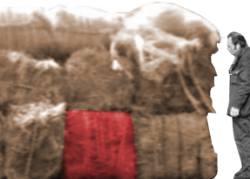
Not all 'bales' were neat and tidy, the photograph below was taken in the later 1930s and shows men handling loosely baled North African esparto grass, destined for use in paper making. Presumably the Africans could not at the time afford presses, or the jute wrappings, and pre-war pictures usually show a lot of loose grass lying about the place.
Fig ___ Bales of African esparto grass (late 1930s)
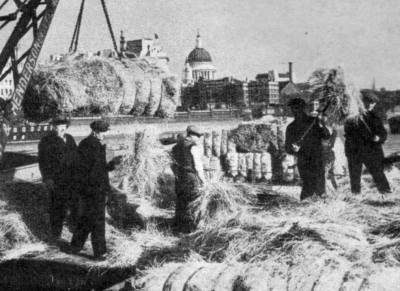
Bales were a common sight in the docks, and by extension on the railways. Materials shipped in bales included wood pulp and rubber (the rubber was in thin pale grey sheets bound together in heavy blocks (a difficult lift for one man) about 3 feet (90cm) square by 15 inches 38cm thick) Cassia (from the cinnamon plant), hemp (a brown fibre used for ropes), kapok (a white fibre similar to cotton but too brittle for spinning, it is used as an upholstery material and in life-jackets) and sisal fibre (light brown to reddish fibres, used for upholstery, low grade sack cloth, twine, carpet backing and linoleum floor coverings). All of these were regularly seen loaded high onto barges from ships and shipped by rail to be delivered to factories piled high on horse drawn or motor wagons.
Carpets were shipped rolled and covered with light brown hessian cloth, smaller rugs (up to about six feet square) were shipped as bales (individual rugs would be shipped rolled up as for carpets).
Glass Bottles and Carboys
Liquids can be shipped in containers made of glass, wood or metal. Glass containers have been used for hundreds of years, in the present context they were mainly shipped in wooden cases, usually packed with straw. A lot of chemical liquids were shipped in large (2 pint or one gallon), usually square section, glass bottles which were in turn boxed in light wooden crates. The crates in widespread use contained two or six bottles and in some cases additional packing (straw) was also added. Carboys are (usually) spherical glass bottles with a short neck at the top used for small quantities of liquids (acids and distilled water were usually shipped in carboys), these were transported in tapering wicker baskets, packed with straw. The basket can be represented using the flared rear end of a 0.177 air gun pellet packed with Milliput and with the top 2mm of a Peco track pin pressed into the putty whilst still wet to represent the neck of the carboy. The former Merit 'OO' range included a set of these carboys which were widely used into the 1960's.
Fig ___ Glass containers and Carboys
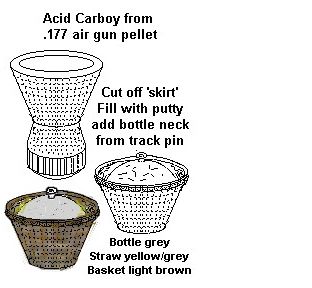
Casks and Barrels
A 'barrel' is but one size of cask, a cask being a container made of wooden staves held together with hoops. Casks could be broken down into staves, ends and hoops for moving when empty, and the 'cooper' who looked after the barrels was an important man in the docks and in larger factories. On the railways and at smaller works the empties were usually shipped intact. The characteristic bulging shape of a barrel means that it can be rolled around easily and they were seldom seen on their ends, having rolled them to where they were put there was little point in going to the effort of tipping them up. Barrels are technically casks with a capacity of 30-40 gallons (136-182 litres).
The sizes of wooden casks were semi-standardised, although there was some variation and a 'beer lorry' delivering to a pub might carry casks of slightly differing sizes (although the majority would be to some particular size). For modelling purposes typical dimensions might be taken as:
Kegs are small barrel shaped casks with a capacity of ten gallons or less (45.5 litres just under two foot long by just over a foot wide). The term is also used for the small steel cylindrical pressurised containers used for modern 'pasteurised' beer. a restaurant near where I live uses these, they are eighteen inches maximum diameter (over the side ribs) by twenty four inches maximum height (to the top of the rim, the top of the container being some three inches below this). (Keg beer has become increasingly popular (at least with the breweries) since the 1960's. This is essentially beer which is artificially conditioned so it has a longer shelf life (although the taste is arguably inferior). In England, the most common size is 9 gallons (a firkin). Steel kegs holding 18 gallons (kilderkin)) are also available as are 4.5 gallon kegs. Scottish brewers (and some English and Welsh breweries) tend to use 11 gallon containers instead of 9 gallons and 22 gallons instead of 18gallons.) These steel beer kegs were shipped by rail as palletised loads with either four or eight kegs (double stacked) per pallet.
Firkin A 'beer' measure of a quarter barrel or 9 gallons, hence technically a 'keg' (see above). Not a common size of cask (other than for gunpowder, at least in the Nineteenth Century) roughly eighteen inches long by fourteen inches in diameter.
Kilderkin (half barrel) holds 18 gallons (imperial) and is 25" long by 20" max diameter. Potatoes and other vegetables were often shipped in half barrel sized wooden casks but these were light weight and simple in construction, the hoops holding the staves together were often thin strips of wood nailed in place. One end was left open and after filling this was usually stuffed with straw and bound with rope to keep the potatoes in place.
Barrel holds 36 gallons (imperial) and is 30" long by 25" max diameter (however the 'herring barrel', used for dry goods is 26 2/3 gallons capacity and slightly smaller)
Hogshead holds 54 gallons (imperial) and is 45" long by 38" max diameter. Commonly used for beer, wines or spirits these are about as big as a man can handle easily.
Puncheon holds approx 72 gallons, close to five feet long by four feet in diameter. This is the largest barrel that would fit through the drop door of a standard five plank wagon. Puncheons were used mainly for lighter oils I believe.
Butt is a very big barrel, holding either 108 (beer) or 126 (wine) gallons. The larger size was used for imported wine I believe.
Ton or Tun is the equivalent of two butts, this was actually used as a measure for fish and I believe it was based on the smaller Butt giving a capacity of about 220 gallons, or just about bang on 1,000 litres which would be just over a ton in weight when full of beer.
Asphalt was shipped in wooden barrels of about hogshead size and ginger was sometimes shipped in half barrel casks. Sherry was shipped in small casks and Scotch whiskey is matured in old Spanish sherry barrels, taking some of its flavour from the matured wood. The Japanese, when trying to copy the process, used South African sherry casks which resulted in a slightly different taste.
One source for N Gauge wooden kegs is a bracelet made up of small wooden beads. These are quite 'barrel' shaped and you get more than a wagon load on a single bracelet. I have seen these bracelets for sale in 'craft shops' over the last ten years or so, so they must be some kind of standard item.
Larger barrels can be modelled using wooden barrel shaped beads, although you need to cut the ends off as they tend to be much too elongated as bought. Glass beads cannot easily be cut but they can be covered with a tarpaulin to provide the shape of a barrel load.
There are (I believe) some white metal wooden barrels available in N, however I am not sure which manufacturer is currently offering these. Ship modellers have a range of cast white metal barrels and kegs available to them, the smaller examples, although expensive, can serve for an N Gauge layout.
For post mid 1960's layouts steel beer kegs can be made using 3mm diameter tubing packed with Milliput, leaving a distinct 'rim' at the top. Adding two ribs of 10 thou rod improves the look of the thing and to represent the filling cap a tiny dot of coloured paint in the centre of the Milliput serves well enough (the kegs I saw when working in pubs in the 1970's had a blue soft plastic cover over the filling cap). For a sheeted load short lengths of tube cut from the ink cartridge of an empty ball point pen can be bedded into Milliput on a rectangle of card. The card can then be supported on an inverted T of card to sit at the right height.
The old Merit 'OO' range included some smooth sided barrels which, although supplied in brown, are I believe based on the steel beer barrels introduced in the later 1950's. Paint these silver then coat with mat varnish to produce a dull metal finish (I have heard that 'aluminium' paint has appeared which has a dull finish but I have not yet tried it myself).
Fig ___ Casks and Barrels

Barrels were not usually marked on their sides as this would be worn off or obscured by dirt as they were rolled about the place. The markings used were therefore usually found on the ends timbers. These were frequently of a lighter colour than the side staves and adding a band of colour across the end seems to have been common practice.
Not all barrels were barrel shaped, tobacco was shipped in straight sided 'hogsheads', technically these were however barrels as they are mode up of strips of (rather pale) wood held together with metal hoops (for an photo of these see Lineside Industries - Industries associated with docks and harbours).
Tins and Steel Drums
Thin sheet metal containers are usually called tins although the metal may not be tin-plate. One common application was the biscuit tin (technically a 'stock box'), about a foot square and standing perhaps fifteen inches high they had a close fitting metal lid held in place by the glued-on paper wrapper laid round the sides. The biscuits were sold by weight in the shop and these remained common into the late 1960's.
Prior to (and to a lesser extent after) the second world war considerable numbers of light metal tins were used for shipping oils and even petrol. The standard motorists 'petrol tin' was a squarish two gallon container, made out of light metal. These were common up to the 1940s. The army preferred a one gallon tin, usually multi-packed in light wooden crates to speed up handling. During the war the army discovered the German pressed steel 'jerry can' was much more robust and switched to using something similar. Other than for petrol the most common size of tin was the 1 gallon type (which resembles the modern 4 litre motor oil tins) but another common size was the larger 5 gallon type which were almost square from the side and had rounded corners. They were slightly narrower than they were high and they had the filling cap on one of the rounded edges. These tins were often packed in simple wooden frames, holding up to five of the one gallon type or just two of the five gallon size.
The one gallon tins work out at about 1mm by 1.5mm by 2.5mm, which is very very small. With care and patience you might turn a few out, adding the filling cap and handle from 10 thou rod, but it is probably not worth the effort. The five gallon type is an easier prospect, the basis would be 2mm wide lengths of Plastruct STFS-6 square tube. Again sand the tube before use to produce the characteristic rounded corners and use the block of wood G-clamped to the mitre box to keep the size consistent. Once cut fill the centre of the squares with putty, leaving this slightly proud and when dry sand the thing smooth.
The handle and filler cap can be represented by scraps of rod. Paint the sides red, blue or green and add some 'writing' with dots of paint, the top, bottom and ends were usually in a different colour (I usually paint the top bottom and ends light grey) and the filler cap was often silver. To make the wooden framed pairs leave the wooden block in place on the mitre box and cut a supply of lengths of 30 thou x 30 thou rod (you need eight of these for each pair of tins but make a few spare). Now you need to cut three slices of Plastruct STFS-10 to form the two ends and middle frame. Paint all the parts for the frame and the tins before assembly, the frames should be in 'natural wood' (light earth). When the paint has dried use the tip of your modelling knife to scrape the corners of the frames where the bars are to be glued. Assemble the 'tins' with the square 'frames' to either end and between them and add the short lengths of rod between the corners of the frames complete.
Steel drums appeared in Europe in the later nineteenth century but the early types were 'barrel' shaped, had riveted seams and tended to leak. In 1907 welded seams were developed and the modern cylindrical drum appeared on the scene. Sometimes this required a coating on the inside, examples requiring this treatment include liquid latex, and dangerous liquids such as acids. The very early drums had no ribs, making them more difficult to move about and a lot more difficult to lift using ropes. By the time of the first world war many drums had ribs, either metal strip welded on or made by adding corrugations to the wall of the drum during manufacture. Before the second world war there were plain sided drums (usually associated with chemicals such as bleaching powder), drums with a number of corrugations in two groups and the familiar modern drum with two single corrugations on the sides. The ribs on the drums allowed a lifting rope to be passed round the barrel and also made them easier to control when rolling them about. The corrugated drums were and are mainly used for chemicals with petroleum oils (mainly lubricants) coming a close second. In Britain the standard size soon became the '45 gallon' drum but in America a 55 (US) gallon drum was adopted, however these must be pretty close in size as 45 UK gallons is 54 US and 55 US gallons is 45.8 UK gallons. There is some slight variation in size but a good estimate of the drum size would be 22 inches (55.9 cm) diameter by 36 inches (91.4cm) long with two rolling ribs dividing the drum into three equal lengths. There are two basic types, those for liquids usually have a filling cap in one end and a bung half way up the side, those for powders usually have a removable end held in place with pressed metal clips around the edges and no bung in the side.
You can buy these drums from various suppliers (notably Ratio, who offer them as part of a set including pallets) and that is probably preferable if you only need a few. You can make some yourself, Plastruct TBFS-4 is the closest match in N, cut 7mm lengths, fill the ends with Milliput and add the ribs using 10 thou rod (sanding the ends smooth should give you a 6mm long drum). To make a lot cut 6mm lengths of Plastruct tube (TBFS-4) using the mitre box with the wooden stopper g-clamped as above. Fill all ends with putty and leave to dry before sanding (gently) smooth. Take a length of mono-filament fishing line and glue one end to a drum, then wind the line round the drum and round the next and so-on. Repeat with a second length, winding in the same direction (so the joining lengths are all on the same side of the drums) and keeping the tension so they lay snug against the drums. You end up with a string of drums which can be laid along the ground with the joining lengths of fishing line at the bottom. To make drums standing on end coat the side of the row with the joining links of line with Uhu and fold the row in half, producing two rows of drums side by side. A wash of varnish followed by a wash of black paint secures the line (whist the varnish is still wet you can gently ease the loops of line with a modelling knife to get them even).
A variant on the drum is the pail, basically a metal bucket with either a filling cap in the top end or a lid clipped in place as for the drums. These have always been widely used for paint but they are also used for chemicals, grease and oily lubricants, cooking oils and lard. Pails range in size from small 1 pint containers up to quite large 5 gallon tins and were cylindrical rather than tapered like a bucket, the smaller types were often fitted with a wire rod handle. These often had a colourful logo printed on their sides.
Fig ___ Drums and Tins
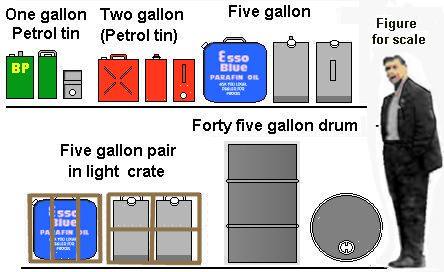
Cardboard
Flat cardboard was invented by the Chinese over five hundred years ago but was only occasionally used for packing by the time the railways appeared. The main problem with this material was that it did not stand up to moisture. In 1871 someone in England began producing ready-made cardboard boxes using this flat card but goods packed in these were shipped in wooden cases to protect them from damp. One solution was to coat the card in wax, which gave it a yellow colour, and the army used such cartons for a range of duties. When shipped in bulk however these waxed card boxes would still have been packed in wooden cases. Corrugated cardboard was patented in England in 1856, consisting of a sheet of thick card with a second corrugated sheet glued to it. The British used it as a lining for tall hats but in the 1870's something very similar was patented in the USA for use as a packing material for glass items. Double sided corrugated cardboard, which forms a rigid sheet, was developed in the USA a few years later and in the 1890's an American woman working in a box factory used this rigid form of the material to develop the pre-cut fold-up cardboard box. These can be shipped packed flat, I believe in the early days a brown paper wrapper was added to the pack. In the 1920's a British paper firm developed Kraft paper, a strong kind of brown paper that was more resistant to moisture and could be used to make cheaper corrugated card boxes (it also allowed the development of the paper sack, see above). By the 1930's the corrugated cardboard carton was in widespread use, by the early 1950s they represented at least fifty percent of the packages seen in pictures of goods sheds. Thanks to the 'fold-up-box' idea almost all cartons were made to a limited range of sizes (I have not been able to confirm what these were) so on a model several consignments would appear as one large collection of cartons.
Newsprint (which is the paper not the ink) was carried, at least in the early BR days, in rolls about 5 foot long by 3 foot in diameter. These rolls were wrapped in brown paper, and usually had a large white label, about a foot square pasted on the side. They were generally stowed on their ends in warehouses or large ships, to prevent crushing and deformation of the roll, in barges and railway waggons they would be laid on their sides as there wouldn't be sufficient weight on to crush them. By the mid 1930's most news print travelled by road as there were problems with the use of standard railway stock. Loading had to be done very carefully to avoid damage and as due to their size and weight they were usually loaded in open waggons where the risk of water getting through the tarpaulin covers was a problem. These rolls provided the impetus for the first British railway wagons with sliding roofs in the late 1950's. Designed by McGreggors and based on a successful design they had developed for use on ships holds a couple of years earlier the roof consisted of a series of plates which folded like a concertina toward one end of the waggon. The roof is an integral part of the wagon, when in place is waterproof but when open almost all the top of the waggon is open for access. The paper rolls are only lifted on and off the waggon at dedicated locations or at ports. They were originally lifted by a set of tongs, operating like scissors, with the 'blades' curved to fit round the roll and the 'handle' end linked to wire lifting strops. More recently, since the late 1960's, specialised lifting gear has appeared, such as a frame with a series of prongs which insert into the centre of the roll and grip it, lifting as many as eight rolls in a single go, an alternative system uses a vacuum cup which fits on the end of the roll for lifting. Although newsprint migrated to the roads the railway companies retained a lot of other forms of paper shipment and containers were frequently used for the more valuable forms of paper cargo.
Bulk Materials
Materials shipped in bulk (ie without any form of packaging) include grain (more so after the Second World War and mainly imported rather than domestic grain), sand, coal, coke and metal ores. Timber was shipped loose prior to the 1970s after which some pre-cut timber was shipped strapped onto pallets. Modelling these materials is discussed in Volume 1 Cargo & Wagon Loads and the comments there apply to similar materials stored on-site at a factory or docks.
^
Go to top of page
International Good Guys ~ Making the world a
better place since 1971 ~ Site maintained by

All material Copyright © Mike
Smith 2003 unless otherwise credited















